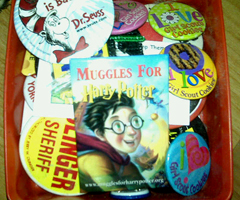More Banned Books Week Resources
September 24, 2010
 One of my cherished possessions is a Muggles for Harry Potter pin from 1999. Eric Crump gave it to me, having picked it up from the NCTE librarian. I hadn’t read a word of J. K. Rowling’s first book, but I was willing to join the anti-censorship campaign.
One of my cherished possessions is a Muggles for Harry Potter pin from 1999. Eric Crump gave it to me, having picked it up from the NCTE librarian. I hadn’t read a word of J. K. Rowling’s first book, but I was willing to join the anti-censorship campaign.
I wish all adults understood that while they are responsible for helping their family choose books, they aren’t responsible for telling the rest of us what we can read. Since the world doesn’t seem to work that way, we talk about banned books and the problems of censoring ideas in the classroom.
When I posted a list of Top 10 Things to Do with a Banned Book earlier this week, I was accused on the English Companion Ning of being biased and working to indoctrinate students. Sigh . . .
I guess I do have a bias: people should be allowed to choose what they read. I fundamentally believe that students and families should be allowed to reject a text that doesn’t fit with their beliefs and values. But no one should be allowed to make that decision for everyone else.
I advocate choice, and I do so by talking about banned books. I want students to know that books have been banned. I want them to know how and why they get banned so that they understand censorship. And yes, I want them to realize that individuals should be free to read what they want.
Since I posted my Top 10 Things, some additional resources have been released. Some, unfortunately, have been created in response to a sweeping call for censorship by Dr. Wesley Scroggins. If you want to learn more about censorship or to find some additional classroom resources, check out these resources:
- Bloggers Speak Out—and give away a bunch o’books! is a round-up of links related to Dr. Scroggins’ call for censorship.
- School Libraries and Censorship provides links to several articles on censorship and how to deal with often-challenged books.
- 10 Ways to Celebrate Banned Books Week With The New York Times collects links to NYTimes articles and other resources with related discussion questions and suggested activities. —I think they copied that 10 Ways gimmick though :)
- 2010 Banned Books Week in Second Life offers some ALA-sponsored events you can participate in from the comfort of your home computer.
- Powerful Memories, Powerful Words, from PBS, explores Mark Twain’s decision to use vernacular language and the word nigger in his Huck Finn.
- Still Speaking Loudly for #SpeakLoudly shares how teacher and librarian Teri Lesesne fights book banning by buying challenged books and sending them to teachers who need classroom copies.
- Persuasion, Argument, and Book Banning in 10 Steps is my post on classroom activities on the use of persuasion and argument by the people involved in banning a book.